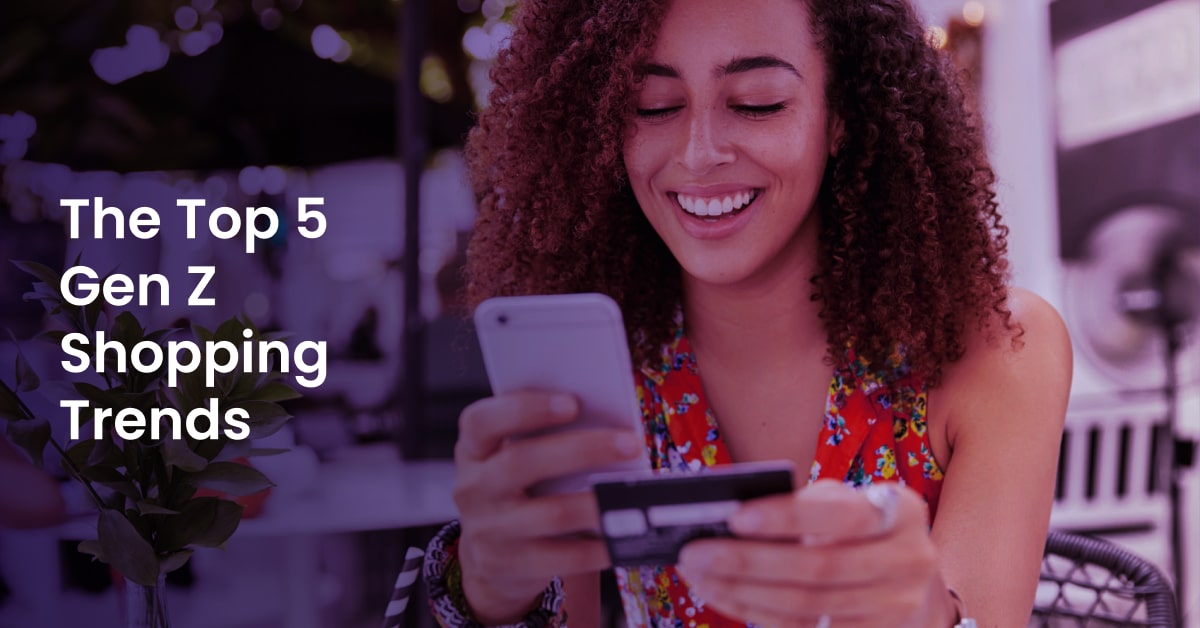With more than $360 billion in disposable income, brands that move fast to serve Gen Z will win. Understanding how Gen Z likes to shop is crucial to maximizing conversions and engagement. Capture more conversions in this market by leveraging these shopping trends.
The Top 5 Gen Z Shopping Trends
As you review these shopping trends, take a moment to review each one carefully. Ask yourself (and your team) where your business could make changes to accommodate these trends.
1) Social Proof Is Still King
Social proof has long been one of the most crucial marketing factors. With Gen Z, recommendations from friends, family, and other trusted individuals remain critically important. Assess your product pages, post-purchase marketing, and presence on third-party sites (e.g., Trust Pilot) for social proof.

Here are a few ideas to emphasize social proof for Gen Z in your marketing:
Encourage informal reviews
Logging into your website or platform to write reviews may feel like too much work for some people. Informal reviews can help you. Your social media posts encourage customers to tell you what you like about your products. These comments can inform your marketing efforts.
Your live shopping and online events can help you to generate reviews and social proof. With Arena Live blog, you can pull in posts from any accounts or hashtags you want.
Boost referrals with a Gen Z focus
There’s no reason to sit on your hands and wait for word-of-mouth recommendations to start. Give incentives to your customers for introducing you to others. To spark Gen Z engagement, make sure you create content in Gen Z-friendly formats like short-form videos (i.e. 30-60 seconds).
There are no shortcuts to building honest, positive reviews from happy customers. However, there is a way to rent social proof and credibility: working with influencers. That’s the next Gen Z shopping habit we’ll unpack.
2) Influencer Content Drives Engagement And Purchases
Gen Z constantly participates in the influencer economy as content creators, supporters, and enthusiasts. Platforms like Patreon and Kickstarter make it easier than ever for creative people to engage their audiences online. You can shortcut the social proof process by working with Gen Z influencers. Use custom tracking links and coupon codes to track the campaign results.
Smaller influencers with audiences under 10,000 may be willing to feature your product if you send it to them for free. More established influencers are likely to expect a fee. Before paying an influencer, get clarity on their audience and ask about their past campaigns.
There’s one drawback to conventional influencer marketing campaigns. Most of the action takes place away from your website. Instead of simply asking influencers to post about your brand on their social account, integrate those posts into your website. For example, you can host a digital event experience on your website by embedding YouTube. By hosting the event on your website, you have more flexibility to add calls to action and track conversions.
3) Offer A Sustainable Shopping Experience
Gen Z consumers care more about sustainability and corporate social responsibility than almost any other demographic. First Insight found that 75% of Generation Z consumers prefer sustainability over the brand name of a product when making a purchase.
How do brands win by appealing to Generation Z’s sustainability sentiments? The answer depends on your company’s strategy. First, review your company’s sustainability achievements and policies. Find out if there is anything genuinely impressive to celebrate. If the answer is no, it’s time to plan a new initiative. Proclaiming a commitment to sustainability without backing up your words exposes your brand to accusations of “greenwashing” (i.e., sustainability hypocrisy).
Use these tips to leverage sustainability in your Gen Z marketing campaigns:
Explain what you don’t use or do in your products and supply chain.
Some companies proudly use vegan products exclusively. Others focus on local-scale supply chains to reduce transportation costs and carbon emissions. Still, some companies apply a rigorous selection process for vendors to reduce costs. Use that fact in your marketing if you have excluded ingredients or processes from your company to improve sustainability.
Communicate your carbon footprint goals
A growing list of companies, including H&M (clothing), Cisco Systems (enterprise technology), CVS (health), and Etsy (marketplace), have set public net zero carbon emissions goals. Recently, these goals have shifted toward “net zero” goals. That means setting a date your company will not make a carbon impact. Achieving this goal may take several forms, like reducing waste, using LEED-certified buildings, and buying credits.
Market charitable partnerships and campaigns
Allow your Gen Z buyers to support sustainable practices with each practice. For example, you might donate $1 from each purchase to an environmental group like the Sierra Club, Rainforest Alliance, or Greenpeace. To deepen your connection with Gen Z consumers, find a Gen Z spokesperson at the charity or nonprofit to appear in videos and other collateral.
4) Make mobile payments easy
Expecting Gen Z customers to put down their phones to complete a purchase means lost revenue. Shopping research reported by Insider Intelligence found that 60% of Gen Z prefer to make payments using their mobile device. The shift to mobile payments will affect physical retailers even more. A May 2022 survey of UK consumers found that over 70% of Gen Z consumers are abandoning their physical wallets and switching to mobile devices.
Satisfying this mobile payment trend requires collaboration between marketing and technology. At a minimum, ask a friend unfamiliar with your website to make purchases on your website. Track how long they take to complete the purchase. Also, check if they have to resort to extra effort (e.g., zooming in and out to fill in a different field).
While the mobile experience is vital, the desktop web experience still has an important place. We’ll turn to that shopping trend next.
5) Gen Z Will Ignore Your Website Unless It is Fast and Easy
The central importance of website importance keeps growing. Generally, a website that takes more than 3 seconds to load will lose customers. Further, some surveys have found that Generation Z’s average attention span – 8 seconds – is significantly less than older generations. If your website takes too long to load, you wouldn’t have a chance to connect with Gen Z when they visit your website.
Slow websites don’t just irritate Gen Z, either. The Google search engine tends to favor fast websites over slow ones. If you depend on organic search traffic to grow your business.
Improving website speed and usability takes time and experimentation. Start by running Google’s Core Web Vitals on your website. Check the desktop and mobile experience. Failing to pass this assessment will likely leave your website at a disadvantage. In addition, use Google’s PageSpeed Insights tool to find additional opportunities to optimize your website performance.
Types of Gen Z Shopping Experiences
Understanding Gen Z’s shopping experiences guides strategy.
Online Shopping Trends
- Mobile-First Shopping: Gen Z prefers shopping on phones. Apps and mobile-optimized sites are crucial.
- Influencer Impact: Influencers drive trust and sales.
Offline Shopping Preferences
- Experiential Retail: In-store experiences must be memorable. Think pop-up events and interactive displays.
- Social Shopping: They enjoy shopping as a social activity, often sharing experiences in real-time with friends.
Benefits of Understanding Gen Z Shopping Trends
Ignoring Gen Z means missing a significant market opportunity.
Market Competitiveness
- Stay Ahead: Competitors target Gen Z. Understanding their trends keeps you competitive.
- Innovate Products: Tailor offerings to meet Gen Z’s unique needs and preferences.
Enhanced Brand Loyalty
- Build Connections: Authentic engagement fosters loyalty. Gen Z prefers brands that speak their language.
- Drive Advocacy: Satisfied Gen Z customers become brand ambassadors.
Personalized Marketing
- Tailored Campaigns: Use insights to create personalized marketing strategies that resonate with Gen Z.
- Higher Conversion Rates: Personalized interactions lead to more sales and repeat customers.
How Gen Z Shopping Trends Impact E-commerce
Gen Z’s shopping trends reshape e-commerce landscapes.
Effect on Product Development
- Adapt to Preferences: Products need to reflect Gen Z’s values, like sustainability and inclusivity.
- Innovative Designs: Stay creative with product designs that catch Gen Z’s eye.
Influence on Marketing Channels
- Optimize Channels: Focus on social media platforms where Gen Z spends their time.
- Engage with Content: Use interactive content to capture their attention and encourage engagement.
How to Reach Gen Z Effectively
Gen Z demands a different approach.
Engage Through Social Media
- Platforms Matter: Gen Z lives on TikTok and Instagram. Meet them where they are.
- Content is King: Create engaging, shareable content that resonates with their values.
- Influencer Collaborations: Work with influencers who genuinely connect with Gen Z audiences.
Implement Real-time Interactions
- Live Engagement: Use tools like Arena Live Chat for instant support and interaction.
- Group Chats: Create community spaces where Gen Z can engage with your brand and each other.
- Feedback Loops: Encourage real-time feedback to improve and adapt your offerings.
Use Authentic Influencers
- Relatability Wins: Choose influencers who align with your brand and Gen Z’s values.
- Genuine Endorsements: Authenticity is key. Gen Z can spot inauthenticity a mile away.
Tips for Capturing Gen Z’s Attention
These tips help capture Gen Z’s elusive attention.
Create Interactive Content
- Polls and Quizzes: Engage with interactive elements.
- Live Streams: Host events or product launches live.
Highlight Sustainability Efforts
- Transparency: Be open about sustainability practices. Gen Z values honesty.
- Eco-Friendly Products: Showcase sustainable and ethically made products.
Offer Seamless Mobile Experiences
- Mobile Optimization: Ensure websites and apps are mobile-friendly.
- Fast Checkout: Simplify the purchase process to prevent cart abandonment.
The Critical Ingredient In Gen Z Shopping
Understanding these Gen Z shopping trends is the journey’s starting point, not the end. The specific market preferences in your industry may be different. Some markets, like book readers, ultimately want to enjoy a non-digital experience with a book. Other segments, like gaming enthusiasts, tend to lean toward a highly digital experience. Traditional analytics platforms will only tell you some of the answers here.
To understand your audience better, you need to gather first-party data from your audience, by tracking which content, online experiences, events, and web pages your audience likes, optimizing marketing campaigns gets much more straightforward. Learn how Arena Personas can help you better manage your first-party data to understand Gen Z buyers more effectively.



